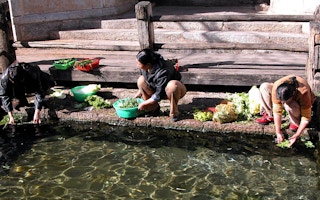The stalks left after the soy harvest in the village of Tatou are still green. By mid-autumn, most crops in northern China have been harvested. But here on the outskirts of the city of Shijiazhuang, radishes and cabbages remain in the ground, soaking up a little more nutrition before the frosts arrive. You would never think this place has a water shortage.
Tatou resident Geng Huiying certainly doesn’t: “Everyone in the village uses the well for water. There’s plenty.”
In fact, the North China Plain, where Shijiazhuang is located, sits atop the world’s largest “cone of depression” – a drop in the water table created by groundwater extraction. The ever-deepening cone is the price of “plenty” of water, as villagers drill well after well, deeper and deeper, to meet growing demand.
Going deeper underground
An average Shijiazhuang citizen uses 229 metres cubed of water per year, according to the Hebei provincial government. That’s a mere tenth of the national average and half the 500m3 international standard for “absolute scarcity”. Even with extra supply arriving via the South-North Water Transfer, Shijiazhuang experiences a 1 billion m3 water gap every year.
Zhi Huazi knows about local water shortages. He’s been drilling wells around Shijiazhuang for 20 years. The elder villagers once told him that 50 years back you could “dig down with a spade a few times and the water came flowing out.” True or not, Zhi confirms wells have had to get deeper, for less water, flowing under less pressure.
He explained that he regards any well of less than 200 metres as shallow, suitable only for irrigation or industry. Drinking water wells need to go down 400-500 metres. He knows of one recently drilled that went past 600.
The groundwater level of a monitoring well fell 17m between 1999 and 2013 – about a metre a year – according to data from the China Geological Survey.
“
People aren’t aware enough of water shortages, so they don’t value it. There’s a lot of work to be done before we create a truly water-conserving society.
Ma Jun, director, Institute of Public & Environmental Affairs
Behind the drop lies over-extraction. According to the Shijiazhuang government, of the 2.8 billion m3 of water supplied to the city last year, 73 per cent was drawn from the ground. One third of that groundwater, 786 million m3, is in excess of aquifer replenishment; in effect, a water deficit.
Eighty per cent of the rain here falls during the rainy season. In drier months, groundwater has to be pumped to meet demand. Both the economy and the population are growing rapidly which is worsening the water problem.
The population of the Shijiazhuang area grew from 9.7 million to 11 million between 2008 and 2018. Industry has been developing rapidly, and Shijiazhuang remains a major grower of cotton and grain. It’s position as “the granary of the north” relies on water.
Government in action
Water-conservation awareness is gradually on the rise and in recent years the government has put in place a series of measures to tackle the groundwater crisis.
Over 5,000 private Hebei wells have been closed since 2017, and the extraction of 420 million m3 of water has been under regulation. In August 2018, the government published a plan for tackling over-extraction. It is targeting a reduction of at least 5.4 billion m3 by 2022; water reuse rates in industry to reach at least 85 per cent by 2020; and efficient irrigation techniques to be applied to 5.66 million mu (373,000 hectares) of farmland by 2022.
The central channel of the South-North Water Transfer, which opened in late 2014, has helped alleviate pressure on local water supplies. It provides Shijiazhuang with an extra 731 million m3 of river water for domestic and industrial use. The latest plans will see river water account for 100 per cent of urban domestic and industrial use by 2021.
And in 2016, Shijiazhuang changed the way it taxes water use, with charges now two to five times higher in areas of over-extraction. In 2017, it started giving companies financial rewards for lower or more efficient use of water.
How to raise water awareness?
Yet even when new sources of water and planned water-saving changes are taken into consideration, the water supply outlook remains grim, according to Sun Suyan of the Ministry of Water Resources. She and others believe water will remain a major factor limiting agricultural and industrial growth in northern China.
In Shijiazhuang, farmers are only allowed to water their fields using special irrigation pipes at a cost of 0.62 yuan (US$0.1) per m3 of water. Some overuse this water, undeterred by the 30 yuan (US$4.2) penalty for flooding a whole field. Others flout the rules by piping free water directly from public wells.
Ma Jun, director of the Institute of Public & Environmental Affairs, an environmental non-profit, thinks that both the public and government will need to make changes to recharge aquifers. The government needs to work on policies, planning and management, put forward water-saving measures and prevent water pollution.
In the agricultural sector, changes in crop structure and reductions in water use for irrigation will help. In industry, old equipment that uses water inefficiently can be changed. Meanwhile, citizens need to be more aware of water conservation and turn that knowledge into action.
“Currently, people aren’t aware enough of water shortages, so they don’t value it,” Ma said. “There’s a lot of work to be done before we create a truly water-conserving society.”
This story originally published by Chinadialogue under a Creative Commons’ License.










